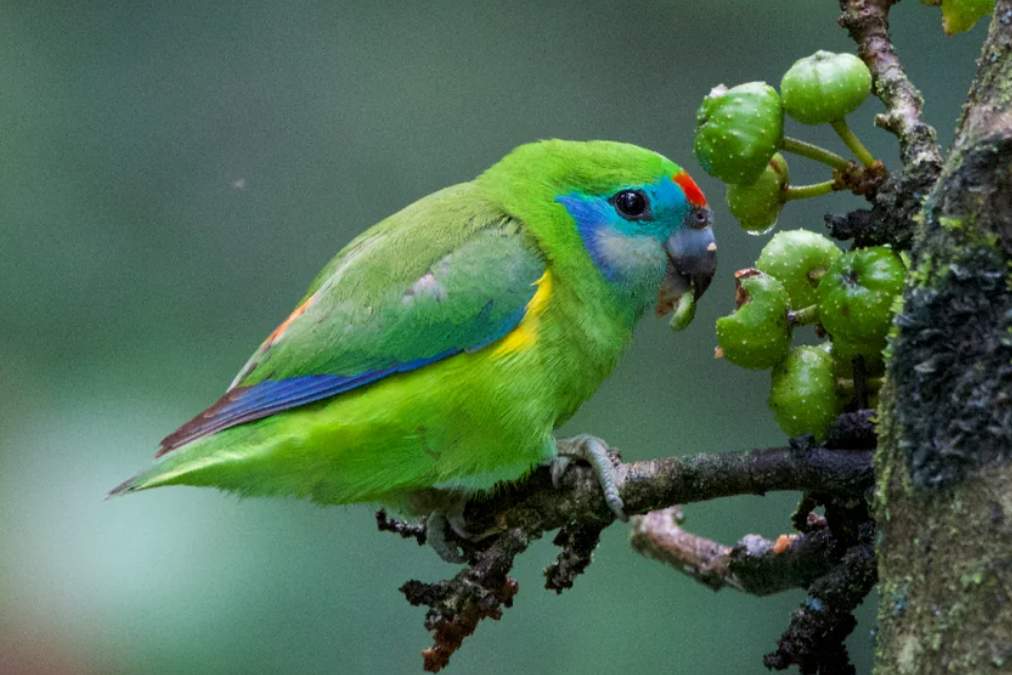In the eastern coastal area of Australia, you can find the passerine bird Yellow-throated scrubwren (Neosericornis citreogularis) which is in the family Acanthizidae.
The songs of more than 30 other species of birds, from the Variegated Wren to lyrebirds, are mimicked by the Yellow-throated Scrubwren in New South Wales and southern Queensland. This beautiful songster, who will sing for up to half an hour at a time, will even interpolate mimicry into its courtship song. Both sexes sing but the female has a softer voice and is a less accomplished singer than the male.
In northern Queensland, there is a separate population of Yellow-throated Scrubwrens, and these have a different voice. Their usual call is loud chattering; otherwise, they are rarely heard to give more than a few whistles. The northern scrubwrens live in mountain and tableland rainforests that are rarely occurring below 600 meters above sea level, or much above 1000 meters.
Southern birds also live in mountain rainforests but extend down to the coast. Despite their bright plumage-these are the brightest of the scrubwrens-its black, yellow, and brown patterns camouflage the birds well on the forest floor where they live. Their propensity for this gloomy place is supposed to have inspired their southern Queensland name Devil-bird.
Sedentary and working alone or in pairs, they hop-search methodically over the litter, moving more quickly than the fern wren with which they share the forest floor in northern Queensland and picking food more from the surface. Insects and seeds and possibly small snails are taken. Occasionally they work up into under shrubbery as well, though spending only 15-25 percent of their feeding time there.
As they hop about, they often chatter noisily. As well as in their call, the northern and southern populations differ also in the choice of the nest site. The northern birds favor lawyer cane and other vine tangles, whereas in the south most nests are suspended from a tree.
These preferences may arise from differences in the vegetation rather than in the birds. The nest design varies. Some nests are up to one meter in length, and some have more than one nesting chamber in them. Small living rock plants up to 30 centimeters long may be attached to the mossy outside of a nest; sometimes there are four or five plant species in one nest.
Therefore, both males and females participate in nest-building, which usually takes 14 days. In one season they may rear several broods, each in a different chamber of the nest. After the successful rearing of one brood, another chamber is lined and used. If the nest has only one chamber, the birds build on another or else construct a new nest close by. Both birds take turns incubating their three brown eggs, for 21 days.
They sit so tightly on the nest, even when approached closely, that they might easily be captured there. Once the eggs have hatched, Yellow-throated Scrubwrens become wary and advertise their presence as little as possible. Both birds feed the young, chiefly on beetles and moths.
The young leave the nest after about 21 days. The Fan-tailed Cuckoo often lays its eggs in the nests of the Yellow-throated Scrubwren. Old Yellow-throated Scrubwren’s nests may also be used by Large-billed Scrubwrens.
It is also known as Devil-bird and Blacknest-bird. The size of Yellow-throated Scrubwren is about 120-140 mm in length. The male upper parts are dark olive-brown; darker and browner on the crown. However, the rump is warm brown; while the upper tail is dark brown. Wing quills are dark gray, primaries edged with green-yellow, coverts dusky with pale green giving a scalloped effect. The forehead, lores, face, and ear coverts are glossy black; eyebrows white merging into yellow towards the back. Chin is white; throat and upper breast are bright yellows; belly white; side of the breast and flanks brown. The eyes are red-brown with black bills. The feet are flesh-cream.
FEMALE: As male; face and forehead are all olive-gray-brown. IMMATURES: The upper parts are mottled with brown; the throat and eyebrows yellow; the chest and belly fawn.
Yellow-throated Scrubwren call is single, sharp tik in contact; harsh loud chatter in alarm. Feeding call of two single notes followed by a doublet. Adults emit harsh low Twitter when approaching the nest. The yellow-throated Scrubwren song is Melodious Whistles. Accomplished mimic in southeastern Australia. In courtship, whistles interspersed with mimicked calls.
The breeding season is August-March. The bird builds a nest a domed structure with a hooded entrance, of black rootlets, palm fiber, leaf skeletons, twigs, ferns, and mosses; lined with feathers; placed either in a vine tangle or suspended from tree branches up to 10 m above ground, often overhanging creeks in which case less moss is used.
The bird lays eggs three, but rarely two or four; smooth and glossy, pale chocolate pink to chocolate brown with a darker zone or a series thereof at the larger end; rounded oval or long-oval, 26 x 18 mm. Incubation is 20-21 days, for both sexes. The young bird fledges in about 21-22 days.
Yellow-throated Scrubwren distribution area is subtropical rainforests of the east coast except for the central east coast, Queensland. It is mainly mountains and tablelands but down to sea level in the south. Two widely isolated races: one smaller, from Cooktown highlands to Paluma Range, Queensland; the other larger, with mimicking song, from about Gympie, Queensland, south to Mt Dromedary, New South Wales.
Related Reading – Superb-fairy wren








